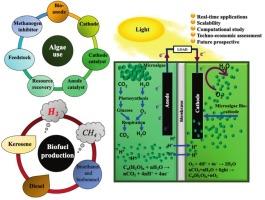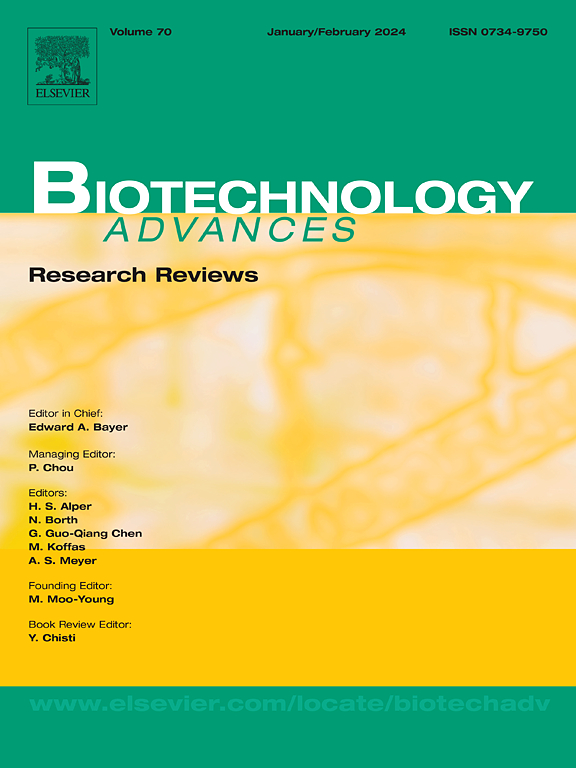藻类驱动的生物电化学系统:最新进展、应用和前景
IF 12.5
1区 工程技术
Q1 BIOTECHNOLOGY & APPLIED MICROBIOLOGY
引用次数: 0
摘要
生物电化学系统(BESs)是近几十年来引起全球关注的可持续生物技术。自问世以来,这些系统已经通过各种配置和修改来提高性能,其中最突出的是微生物燃料电池(mfc)。研究人员正在通过对藻类辅助mfc(藻类- mfc)的研究来解决mfc的规模化挑战,这种技术可以同时产生生物电并经济有效地处理废水。藻类- mfc是碳中性的,在产生氧气(O2)和生物量的同时进行光合作用以隔离二氧化碳。O2是一种有效的电子受体,而生物质是生物燃料的原料,这使得该过程既经济又环保。本文综述了基于藻类的mfc的最新进展,重点是生物发电(高达26,680 mW/m2)和生物燃料产量(200 mL/L/h生物氢、286 mL/g/VS生物甲烷、3.37 g/L生物丁醇、73 g/L生物乙醇和121,104 kg/ha∙年生物柴油),以及生物煤油(生物喷气)技术的创新。反应器组件和配置对藻类mfc性能、缩放策略、实时应用和基于藻类的BESs的计算研究的影响也进行了研究。此外,本文还评估了该技术的技术经济可行性、挑战和未来前景。总的来说,研究结果表明,藻类- mfc可以有效地去除废水中的污染物,增加发电量,同时也为未来的发展指明了方向。本文章由计算机程序翻译,如有差异,请以英文原文为准。

Algae-driven bioelectrochemical systems: Recent advances, applications, and prospects
Bioelectrochemical systems (BESs) are sustainable biotechnologies that have garnered global interest in recent decades. Since their inception, these systems have evolved through various configurations and modifications to enhance performance, prominently featuring microbial fuel cells (MFCs). Researchers are addressing the scaling challenges of MFCs with studies on algae-assisted MFCs (algae-MFCs), which simultaneously generate bioelectricity and treat wastewater cost-effectively. Algae-MFCs are carbon-neutral and photosynthesize to sequester CO2 while producing oxygen (O2) and biomass. O2 serves as an effective electron acceptor, and biomass is a biofuel feedstock, making the process economical and eco-friendly. This review highlights recent advances in algae-based MFCs, focusing on bioelectricity generation (up to 26,680 mW/m2) and biofuel outputs (200 mL/L/h of biohydrogen, 286 mL/g/VS of biomethane, 3.37 g/L of biobutanol, 73 g/L of bioethanol, and 121,104 kg/ha∙year of biodiesel), along with innovations in biokerosene (bio-jet) technology. The impacts of reactor components and configurations on algae-MFC performance, scaling strategies, real-time applications, and computational studies of algae-based BESs are also examined. Furthermore, this review assesses the technoeconomic viability, challenges, and future prospects of this technology. Overall, the findings suggest that algae-MFCs effectively remove contaminants from wastewater and increase power generation while also outlining directions for future advancements.
求助全文
通过发布文献求助,成功后即可免费获取论文全文。
去求助
来源期刊

Biotechnology advances
工程技术-生物工程与应用微生物
CiteScore
25.50
自引率
2.50%
发文量
167
审稿时长
37 days
期刊介绍:
Biotechnology Advances is a comprehensive review journal that covers all aspects of the multidisciplinary field of biotechnology. The journal focuses on biotechnology principles and their applications in various industries, agriculture, medicine, environmental concerns, and regulatory issues. It publishes authoritative articles that highlight current developments and future trends in the field of biotechnology. The journal invites submissions of manuscripts that are relevant and appropriate. It targets a wide audience, including scientists, engineers, students, instructors, researchers, practitioners, managers, governments, and other stakeholders in the field. Additionally, special issues are published based on selected presentations from recent relevant conferences in collaboration with the organizations hosting those conferences.
 求助内容:
求助内容: 应助结果提醒方式:
应助结果提醒方式:


